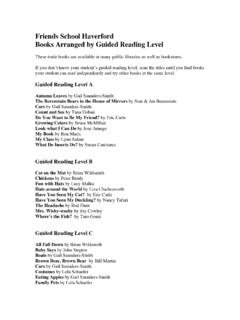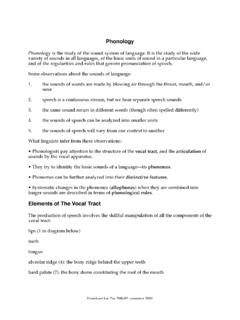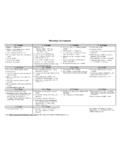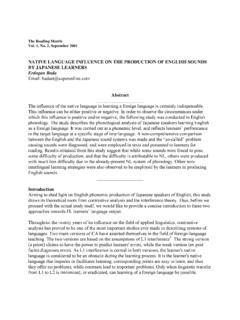Transcription of Speech-Language Eligibility/Dismissal Criteria
1 Speech-Language Eligibility/Dismissal Criteria Revised June 2011 2 TABLE OF CONTENTS Articulation & phonology .. 3 Fluency .. 5 Voice .. 6 language .. 7 Exit Criteria .. 9 Appendix A .. 10 Appendix B .. 11 Sources .. 12 3 ARTICULATION/ phonology The student with an articulation/phonological impairment is unable to produce sounds correctly in conversational speech. This impairment is typically characterized by the omission, distortion, substitution, addition and/or inaccurate sequencing of speech sounds. Errors are not related to culture or dialectal differences. A student is not eligible for special education and related services in the area of speech and language (articulation/ phonological) impairment when: 1. Sound errors are consistent with developmental age or are within normal articulation development (see appendices A & B). 2. Articulation differences are due primarily to unfamiliarity with the English language , dialectal differences, *physical disabilities or environmental, cultural or economic factors.
2 3. The articulation errors do not interfere with the student s ability to benefit from education. *Disabilities that require medical intervention and whose errors are associated with dental/orthodontic abnormalities (this includes students whose speech is affected by a prosthetic device) The IEP team may identify a child as having a speech impairment if the child meets the definition under 1 and meets any of the following Criteria under 2 below: 1. The student demonstrates speech sound errors outside of the developmental guidelines (see appendix A & B) 4 2. There is an adverse effect on: (a) academics or classroom communication due to decreased speech intelligibility (less than 80% intelligibility in connected speech). The child s peers or teachers are not able to understand him/her, therefore hindering oral presentations, oral reading, and the development of social relationships. (b) sound/symbol development, spelling or reading skills related to distorted phonemes.
3 (c) socio-emotional development. 5 FLUENCY A fluency impairment is defined as the abnormal flow of verbal expression at times combined with negative attitudes and feelings about speech. It is characterized by an increase in atypical and typical disfluencies that may also be accompanied by tension and/or secondary characteristics ( body movements, facial grimace, etc). A student is not eligible for special education and related services in the area of speech and language (fluency) impairment when: 1. Disfluencies are part of normal speech development 2. Disfluencies do not interfere with the student s ability to benefit from education. 3. Rate is the only effected area. The IEP team may identify a child as having a fluency impairment for special education and related services if they exhibit one of the following: 1. The student demonstrates 5-8% atypical disfluencies (sound syllable repetition, prolongation and blocks) within a speech sample of at least 200 syllables.
4 Noticeable tension and/or secondary characteristics may or may not be present. 2. The student demonstrates 5-8% typical (word and phrase repetitions, interjections, revisions, unfinished words, hesitations) disfluencies within a sample of at least 200 syllables with one or more of the following: a. accompanied by audible and/or visual tension b. secondary characteristics c. negative attitudes and feelings about their speech 6 VOICE A voice impairment is defined as any deviation in pitch, intensity, quality, or other attribute that consistently interferes with communication; draws unfavorable attention; adversely affects the speaker or the listener; or is inappropriate to the age, sex or culture of the individual. Voice quality may be affected by either organic or functional factors. A student is not eligible for special education and related services in the area of speech and language (voice) impairment when vocal characteristics: 1.
5 Are the result of temporary physical factors such as allergies, colds, abnormal tonsils/ adenoids, sinus problems, short-term vocal abuse or misuse, and maturation. 2. Are the result of anatomic or physiologic deviations. 3. Are the result of regional, dialectal or cultural differences. 4. Do not interfere with the student s ability to benefit from the educational program. 5. Are the result of socio-emotional development. The IEP team may identify a child as having a voice disorder if: 1. The student demonstrates deviant vocal behavior related to pitch, intensity, or quality inappropriate for the student s age or sex that is of concern to parent, student, physician and/or teacher. Frequency and consistency must be considered. **A doctor s order (ENT Exam) is necessary before treatment can begin. A school based SLP cannot diagnose voice disorders. 7 language The student with a language impairment demonstrates impairment and/or deviant development of comprehension and/or use of a spoken symbol system.
6 This includes: language form, language content, and language use. A student is not eligible for special education and related services in the area of language when: 1. Speech/ language difficulties result from a second language , unless the child has a language impairment in his or her native language . This can only be assessed through a bilingual assessment. 2. language performance does not interfere with the student s ability to benefit from education. 3. Difficulties with auditory processing are without a concomitant documented oral speech or language impairment. It is important to note that auditory processing disorder (APD) is not a disability category under IDEA. *Auditory processing evaluations and diagnoses can only be completed by a certified audiologist. 4. language performance is consistent with developmental norms as documented by formal and informal assessment data. 5. language needs can be addressed: (a) Within the classroom setting (resource or general education setting).
7 (b) Through modifications or accommodations made to the classroom environment. (c) Through adaptations in teacher style to successfully support the student s learning. 8 The IEP team may identify a child as having a language impairment if: 1. The student demonstrates a deficit in receptive and/or expressive language as measured by two or more diagnostic procedures/standardized tests. A child must score more than one standard deviation below the mean (this translates to a standard score of 84 or below). ** Individual subtest scores may be used to indicate strengths and weaknesses, however, they may not be used to qualify students for speech and language services. and 2. Clinical observations, informal assessment, and consultation with other school personnel are indicative of a language impairment that has an adverse effect on educational performance. 9 Speech-Language DISSMISSAL Criteria A student is no longer eligible for Speech-Language services when at least one of the following is determined: 1.
8 The disability no longer adversely affects academics as agreed upon by school personnel. 2. The student has been found to have average speech and/or language scores based on a recent evaluation. 3. The student s lack of motivation and participation prevents measurable progress toward meeting his/her goals. 4. The student no longer requires speech/ language services. It is determined that goals and objectives can be met within the general and/or resource classroom. 5. Documented lack of measurable progress despite implementation of a variety of strategies and techniques. The child has plateaued in his/her progress. 6. The student has health issues ( , medical, dental, emotional issues) requiring services to be suspended or discontinued. 7. The student has met all of his/her goals and objectives. 10 APPENDIX A DEVIANT PHONOLOGICAL PROCESSES ACCORDING TO AGE (Kahn and Lewis, 2002) 3 years of age and above, a child should not be producing the following with greater than 40% occurrence: Final Consonant Deletions Weak Syllable Deletion Consistent use of consonant harmony ( tote for coat ; not just luh-lo for yellow ) 4 years of age and above, a child should not be producing the following with greater than 40% occurrence: Cluster Reduction Epenthesis (addition of sounds to words pulay for play ) Fronting 5 years of age and above, a child should not be producing the following with greater than 40% occurrence: Backing (producing a front sound at the back of the mouth ( kime for time ) Initial Consonant Deletion Glottal Replacement ( ba-uhl for bottle ).)
9 11 APPENDIX B Normal Sound Acquisition (Articulation Development) By 3 years of age: All vowels, m, n, h, p, b, w, t, d, j ( ya as in yellow ) By 4 years of age: k, g, f, s, z (except interdental s, z) By 5 years of age: sh, zh, ch, dz ( j as in jump ) By 6 years of age: v, ng (as in ing ), l, voiceless /th/ By 7 years of age: Interdental s, z, voiced /th/ By 8 years of age: r, vocalic r ( er ) **Lateralization of s, z, sh, zh, ch and dz are never considered developmental and should always be treated as soon as they are diagnosed.** 12 SOURCES American Speech-Language Hearing Association (2003). IDEA and Your Caseload: A Template for eligibility and Dismissal Criteria for Students Ages 3 to 21. Kahn and Lewis (2002). Phonological Analysis, Second Edition. Circle Pines, Maine: American Guidance Services Grunwell, P. (1982). Clinical phonology . Rockville, Maryland: Aspen Systems. Illinois State Board of Education (2007).
10 Speech-Language Technical Assistance Manual Individuals with Disabilities Education Act Amendments (1997 and 2004). Washington, DC: Government Printing Office.









